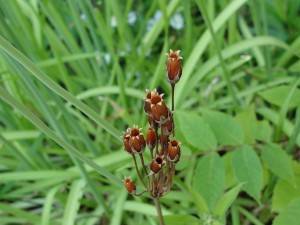
When is the best time to harvest seeds? The secret? A dry day, after the dew dries off. Afternoon is better than morning.
Throughout the growing season, observe your plants as they bloom and then set seed. Any flower that was will eventually have a seed to harvest in its place. Early spring ephemerals may set seed in May or June. Look for signs that the seeds are maturing. For example, Shooting Star seed capsules should turn brown some, such as the picture on the right side of this page. If the stem is turning brown, that is also a sign that the seeds are ready to be harvested. Wild Geranium and Columbine seeds will also mature in early summer, shortly after the flowers have stopped blooming. Sedges will flower and set seed throughout the spring and summer, so be observant and collect when you see the signs. Goldenrod, asters and most of the grasses, being later to bloom, may not be ready to harvest until September or even late October. As you collect seeds, place them into a brown paper bag, label the bag with the plant name and date and store in a dry area.
The Barrington Area Library hosted a How to Collect and Sow Native Plant Seed webinar on September 9, 2020 which was recorded and can be viewed on youTube. In this webinar, Sarah Michehl from The Land Conservancy of McHenry County discusses collecting and sowing native plant seeds. This is a great resource to learn basic seed identification, collection methods and timelines, and tips on how to sow.
The Lake County Seed Collection Guides are a wonderful resource for collecting native seed. These guides were developed by Dale Shields and Kelly Schultz from the Lake County Native Seed Nursery and have been submitted and posted with the Field Museum Field Guides collection. Here are links to these guides:
Illinois – Lake County Seed Collection Guide – Woody Plants
Illinois – Lake County Seed Collection Guide – Spring Woodland Forbs
Illinois – Lake County Seed Collection Guide – Summer Woodland Forbs
Illinois – Lake County Seed Collection Guide – Summer Wetland Grasses and Kin
Illinois – Lake County Seed Collection Guide – Summer Wetland Forbs
Illinois – Lake County Seed Collection Guide – Summer Prairie Forbs
Illinois – Lake County Seed Collection Guide – Summer Grasses and Kin
Illinois – Lake County Seed Collection Guide – Asters and Goldenrods
Illinois – Lake County Seed Collection Guide – Fall Woodland Forbs
Illinois – Lake County Seed Collection Guide – Fall Wetland and Forbs
Illinois – Lake County Seed Collection Guide – Fall Grasses and Kin
Illinois – Lake County Seed Collection Guide – Fall Prairie Forbs
The Field Museum Field Guide, Illinois – Seed Heads of Common Native Plants of the Tallgrass Prairie Region is also a great resource to show you what the common native plant seed heads look like at maturity.
You can find a great list of Seed Collecting Dates on the Pleasant Valley Conservancy website.
One of our chapter’s most popular events is the Annual Seed Exchange. Our 2024 Seed Exchange took place on Saturday, November 9th from 10:00 am to 12 pm at The Growing Place in Aurora. For more information on the event click here and click here for pictures from the event. Look for our 2025 event next fall!
Here is a list of the species that we exchanged in recent years.
To learn about sowing the native plant seeds that you collect, check out the Prairie Moon Nursery Cultural Guide and Germination Codes and Seed Starting Basics. The Seed Propagation Information page on the Prairie Nursery site is also a good source for starting seeds. Click here to watch a recording of the University of Illinois Extension Master Gardener Winter Sowing program with Jan Gricus & Cynthia Cieckiewicz hosted by the Lisle Library District.
Here are some resources to help you identify your seedlings once they start growing:
Central Region Seedling ID Guide for Native Prairie Plants
The Gardener’s Guide to Prairie Plants by Neil Diboll & Hilary Cox
